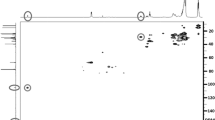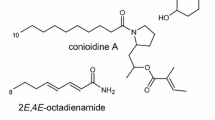Abstract
A low-temperature synthesis of fatty alkanolamides, fatty diamides and fatty aralkylamides directly from triglycerides and primary amines provides essentially quantitative yields of the various products. The reactions run to completion in 3–12 h at temperatures of 50–60°C, approximately 100°C lower than employed in present conventional practice. The amines are used in excess and serve as solvent, reagent and, perhaps, as catalyst. The amides were characterized by melting point and spectroscopic (infrared and nuclear magnetic resonance) methods. If the mixed amides produced from the various natural triglyceride mixtures of fats and oils are acceptable products, this synthetic method provides these products in satisfactory quality while conserving energy and avoiding the intermediate production of free fatty acids or their esters.
Similar content being viewed by others
References
Bilyk, A., R.G. Bistline, Jr., G. J. Piazza, S.H. Feairheller and M.J. Haas,J. Am. Oil. Chem. Soc. 69:488 (1992).
Synthetic Organic Chemicals, United States International Trade Publication #2338, Washington, D.C., Dec., 1990, pp. 15–3, 15–4.
McKenna, A.L.,Fatty Amides, Synthesis, Properties, Reactions and Applications, Witco Chemical Corporation, Humko Chemical Division, Memphis, 1982, pp. 111–194.
Shapiro, S.H., inFatty Acids and Their Industrial Applications, edited by E. Scott Pattison, Marcel Dekker, Inc, New York, 1968, pp. 77–154.
Bistline, R.G., Jr., J.W. Hampson and W.M. Linfield,J. Am. Oil Chem. Soc. 60:823 (1983).
Bistline, R.G., Jr., E.W. Maurer, F.D. Smith and W.M. Linfield,57:98 (1980).
Bistline, R.G., Jr., E.W. Maurer, F.D. Smith and W.M. Linfield, U.S. Patent No. 4,663,353 (1987).
Ralston, A.W., inFatty Acids and Their Derivatives, John Wiley & Son, Inc., New York 1948, pp. 581–710.
Weil, J.K., and A.J. Stirton, inAnionic surfactants, edited by W.M. Linfield, Marcel Dekker, Inc. New York, 1976, pp. 219–232.
Bistline, R.G., Jr., W.M. Linfield, W.B. Wise, P.E. Pfeffer, P.E. Sonnet and E.G. Piotrowski,J. Am. Oil Chem. Soc. 64:744 (1987).
Mod, R.R., F.C. Magne and E.L. Skau,J. Chem. Eng. Data 7:31 (1962).
Roberts, J.D., and M.C. Caserio,Basic Principles of Organic Chemistry, W.A. Benjamin, Inc., New York, 1965, p. 879.
Author information
Authors and Affiliations
About this article
Cite this article
Feairheller, S.H., Bistline, R.G., Bilyk, A. et al. A novel technique for the preparation of secondary fatty amides. J Am Oil Chem Soc 71, 863–866 (1994). https://doi.org/10.1007/BF02540463
Received:
Accepted:
Issue Date:
DOI: https://doi.org/10.1007/BF02540463




